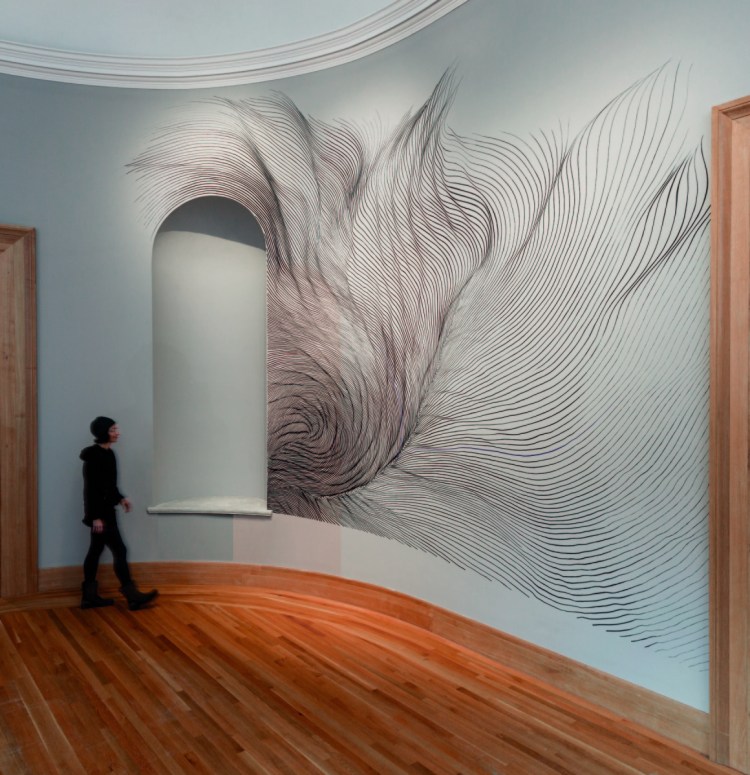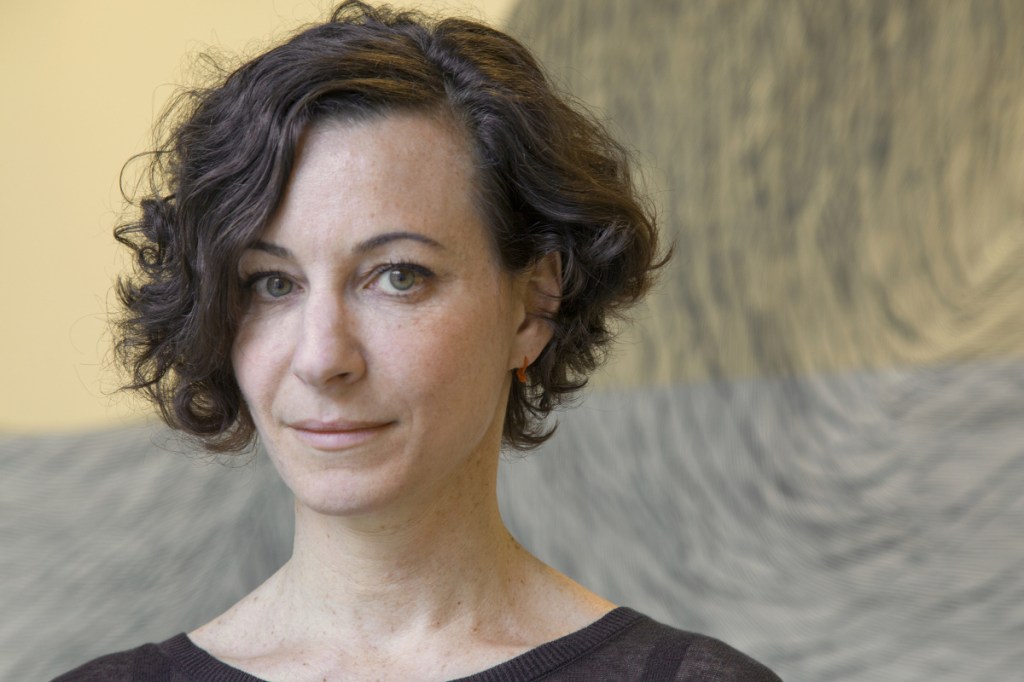Now on view at the Bowdoin College Museum of Art is a drawing installation – “Let’s Get Lost” by Linn Meyers – in conjunction with an interactive sonic installation titled “Listening Glass” by the team of Rebecca Bray, James Bigbee Garver, Josh Knowles and Meyers. To describe it, let’s start with the museum’s very specific verbiage: “Using the drawing as a score, visitors interact with the visual art to generate sound, creating improvised musical compositions through gesture.”
The installation is set in the center room of the Charles McKim-designed museum. It is an elliptical space with a doorway at each of the axis points and a tall curve-topped sculpture niche (now empty) between the doors. The walls are covered with drawings by Meyers: matrices of parallel lines that look like topographical maps, gathering more densely at higher points and so on. The drawing installation on its own is spare and elegant. At the two foci of the ellipse are a pair of industrial music speakers, aesthetically disjointed maybe, but clear in their announcement of a sonic presence.
“Listening Glass” is the musical component of the installation. It is exciting and interactive in concept: Viewers make the sound happen by downloading an app to their iPhones and running the phones over the lines on the wall. The original score composed for the installation is fittingly light, tonal and atmospheric. It has a strong sense of key and a new age feel that made me think of a mellow George Winston at the piano with just his right hand.
The idea is that viewers will walk through the gallery, waving their phones over the wall to create sound. It’s conveyed to us that we have a real sense of agency and improvisational control in this interaction. It’s certainly fun, original and entertaining – particularly when there are several people simultaneously interacting with the piece – but after a while, the limits and repeated specifics raise questions about the extent to which the viewer is actually involved in “creating improvised musical compositions.”
The experience itself drives the questioning of the installation: “How does this work” is the obvious place to start when learning to operate any new instrument or tool. First, you find that the phone needs to be just inches (not feet) away from the wall so that the line indicator works (you see a circle go dark as you pass over a line). This part is compelling. Then, as you pass your phone over the lines, you hear the music – mostly from your own phone. (I didn’t hear much, if anything, from the speakers during my visit.) What you realize quickly is that different pieces of music happen not by how you run your phone over the lines – you start with the assumption that similarly grouped lines in one place will have the same effect anywhere in the room – but where you are in the room. Tilting your phone seems to have a slight tonal effect, but that appears to be the extent of your improvisational control.
As it became clear th sounds were the result of GPS positioning (moving the phone straight up and down, for example, doesn’t remotely have the same effect as moving sideways), my enthusiasm began to fizzle. The iPhone app requested access to my camera (which I granted) and so, in hindsight, I realized I had turned my phone’s GPS data over to the app – and this raises ethical questions. I honestly don’t know the precise technical means used here, but that is exactly why it makes me uneasy.
One of the coolest things about iPhone’s camera is that each picture it takes includes GPS data; this was a reminder that such things can lead people to share far more information than they intend to. (Having visited Kenny Cole’s iPhone-based and philosophically oriented exhibition, “Indigestion,” in Kittery the night before was a fitting prelude.) And because you are being asked to operate your phone to create music, it’s natural to try to figure out what you can or cannot do to “create” within the exhibition. Conceptual art is driven by the mystery of unlocking new ideas, and while this piece has an excellent aesthetic foundation, its function in real time is fueled by the viewer’s curiosity. Your phone is your “wand,” your tool. Like any new tool, it’s a puzzle. So it isn’t just the art critics out there who are going to be driven to unpack what’s going on; everyone will.

“Let’s Get Lost,” detail.
As an art critic, I prefer to go to exhibitions with fresh eyes, saving the reading and the homework for after. When I (later) watched the five-minute video about the show, I heard a few things that made me even less comfortable, including the tech maestro’s comment that “the technology should remain hidden.” I am not saying artists always need to be transparent (illusion has always been a part of the arts, after all) but in addition to putting their GPS tracker on your personal phone, the information about the show implies that you’re going to be able to play the room like an instrument – and that is not the case. For example, it was suggested in the video that a tall person could “hit the high notes” – but GPS doesn’t care if you’re up high or down low. In short, it is not accurate to say the viewer will be “using the drawing as a score”: Where you are in the room (rather than Meyers’ gossamer drawings) determines what part of the recording you will hear – the music is not a product of the lines nor is it accurately described by them. So it’s more like hitting a “play” button in different places than playing an instrument or reading music.
Again, I don’t know the specific technical mechanisms by which “Listening Glass” operates, but for however beautiful, new and exciting it is as an installation, I left feeling hoodwinked.
Freelance writer Daniel Kany is an art historian who lives in Cumberland. He can be contacted at:
dankany@gmail.com
Copy the Story LinkSend questions/comments to the editors.




Success. Please wait for the page to reload. If the page does not reload within 5 seconds, please refresh the page.
Enter your email and password to access comments.
Hi, to comment on stories you must . This profile is in addition to your subscription and website login.
Already have a commenting profile? .
Invalid username/password.
Please check your email to confirm and complete your registration.
Only subscribers are eligible to post comments. Please subscribe or login first for digital access. Here’s why.
Use the form below to reset your password. When you've submitted your account email, we will send an email with a reset code.